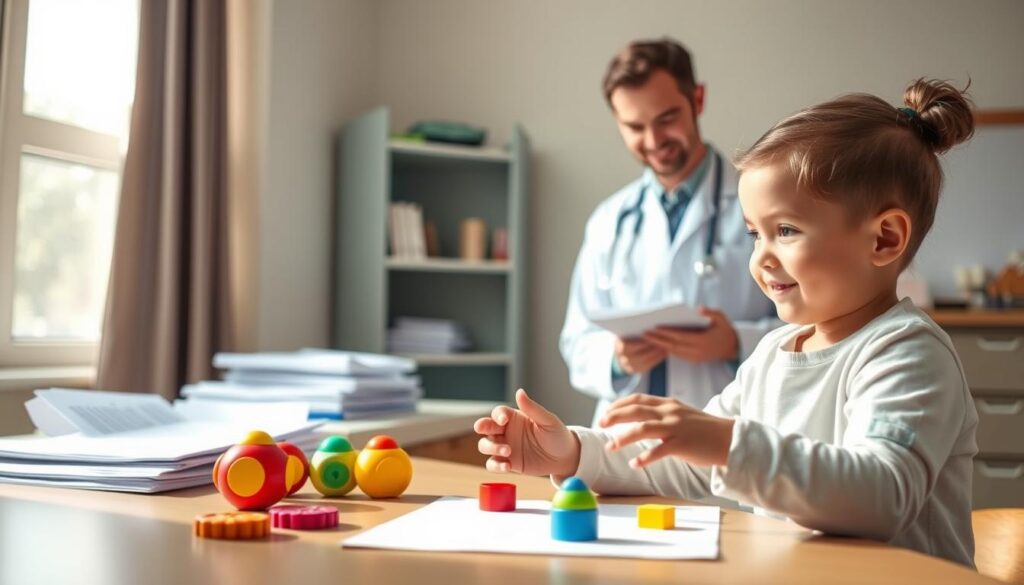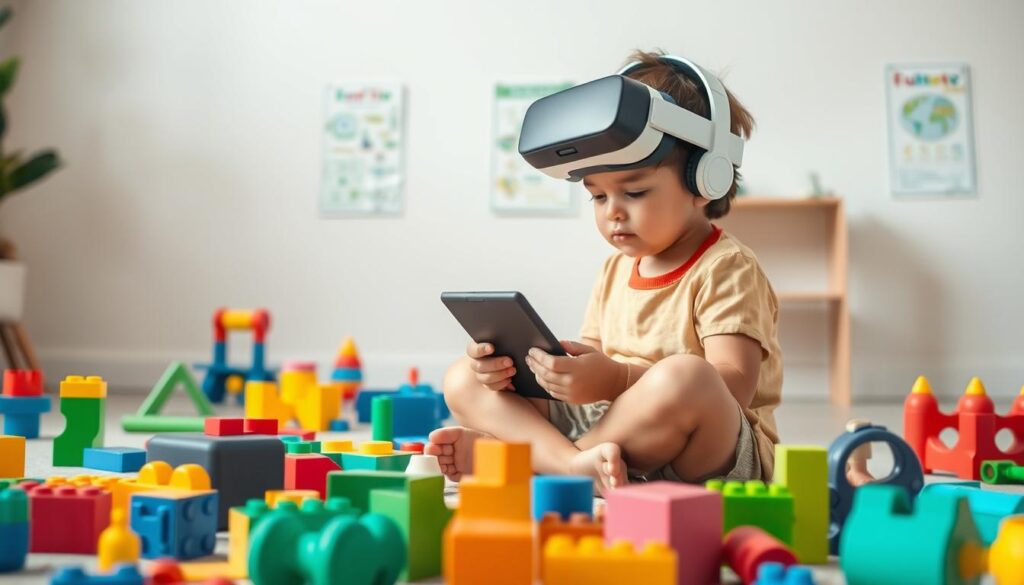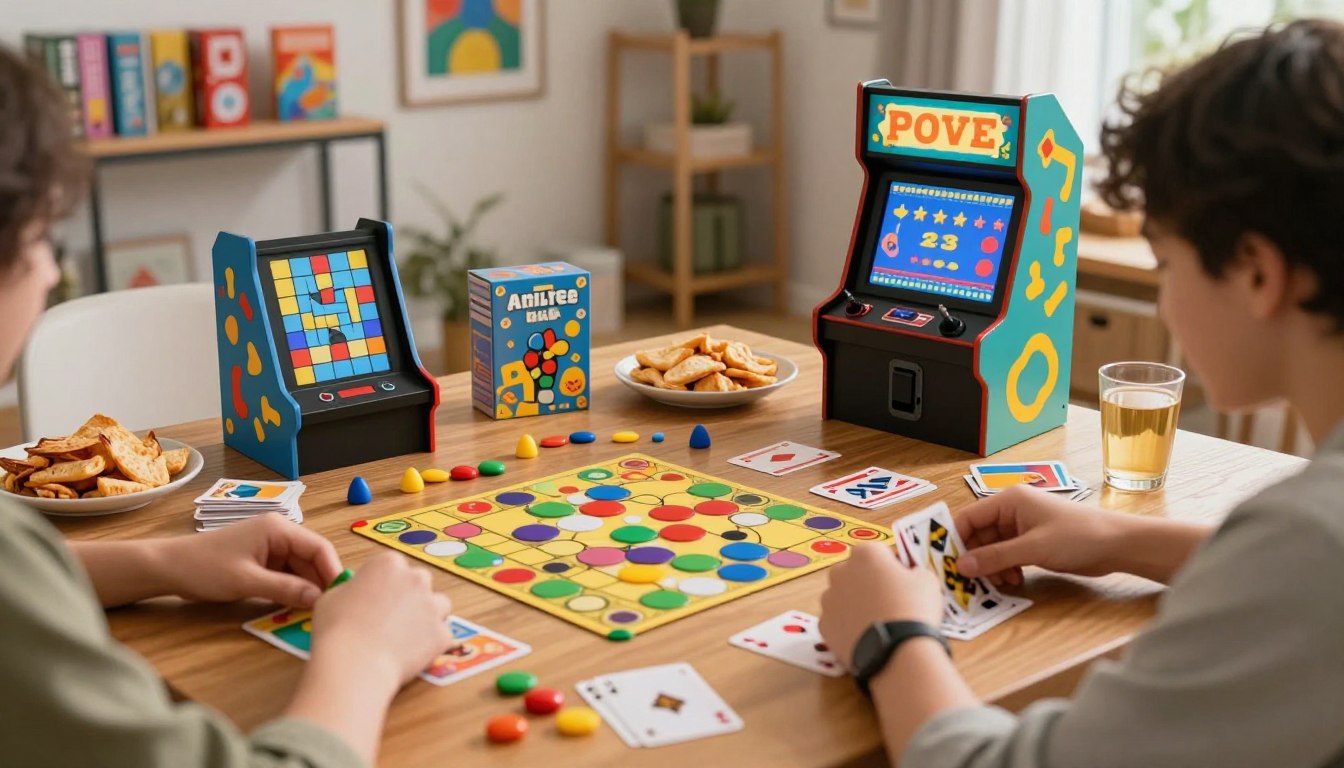Anúncios
Can virtual worlds unlock a child’s potential in rehabilitation? Pediatric VR games are changing the game in motor and cognitive rehab for kids with developmental disorders. These games make therapy fun and interactive, boosting motivation in young patients.
Studies show that these games are making rehab more effective and fun. Let’s dive into how VR games are transforming the way we help kids recover.
Anúncios
Introduction to Pediatric Developmental Disorders
Pediatric developmental disorders cover a wide range of conditions that affect children’s growth and behavior. These disorders can impact areas like communication, learning, motor skills, and social interaction. A big part of this includes childhood disabilities like cerebral palsy, which affects movement and posture.
Cerebral palsy is the most common physical disability in kids, happening in about 1 in 500 live births. It significantly impacts a child’s life.
Children with developmental delays find it hard to do everyday tasks. This can make school and daily activities tough. Their struggles can be physical and mental, affecting their life quality a lot.
Anúncios
Understanding these disorders helps caregivers and doctors create special plans for kids. This can greatly improve their well-being and how well they can function.

Understanding Cognitive and Motor Impairments
Cognitive and motor impairments often make life hard for kids with developmental disorders. Motor issues, like those in cerebral palsy, make it tough to control muscles. This makes it hard to walk and do fine motor tasks, which are key for daily life.
Children with these impairments also face challenges in learning and socializing. The mix of motor and cognitive problems makes treatment harder. It’s important to tackle both areas together.
Using a whole-body approach in therapy is crucial. It aims to improve motor skills and brain functions. New methods, like virtual reality, make learning fun and help kids grow in both areas.
Every child is different, so treatments must be tailored. By addressing both cognitive and motor issues, therapists can create a better plan. This plan helps kids recover and grow more effectively.

The Role of Rehabilitation in Pediatric Care
Pediatric rehabilitation is key for kids with developmental disorders. Early help boosts motor and brain skills, leading to better results later. A team effort is crucial, with experts like physiotherapists and occupational therapists working together.
Rehab uses both old and new methods. It’s all about tailoring care to each child. For example, virtual reality makes learning fun and keeps kids excited about progress.
This approach doesn’t just focus on physical health. It also supports the emotional well-being of kids and their families. This all-encompassing care helps create a healing and growing environment.
What are Virtual Reality (VR) Games?
Virtual reality games create immersive digital worlds. They let users dive into different scenarios. Players use head-mounted displays to move around and interact, making the experience very engaging.
These games are more than just fun. They help improve motor and cognitive skills. They are great tools for rehabilitation.
In therapy, VR games meet the needs of children. They offer interactive ways to practice important skills. This makes learning fun and safe.
VR technology is flexible. Therapists can adjust games to fit each child’s abilities. This helps address different levels of impairment.
VR games mix fun with focused exercises. They motivate kids to enjoy their therapy. This makes learning a positive experience.
Benefits of VR in Pediatric Rehabilitation
Virtual reality (VR) in pediatric rehabilitation offers many benefits. It makes therapy more fun and engaging for kids. This makes the process less scary and more enjoyable.
VR is great for personalized therapy. Therapists can create VR experiences that match each child’s needs. This helps kids learn and grow in a fun way.
VR helps the brain adapt and change. Kids do exercises and get feedback right away. This helps them get better at moving and thinking.
Studies show VR therapy boosts kids’ skills in many areas. It improves their focus and memory. VR and therapy together are a powerful way to help kids.
VR Pediatric Neurorehabilitation Games for Developmental Disorders
VR neurorehabilitation games are changing the game for kids with developmental disorders. They’re not just fun; they’re also super helpful. Games like “GRAIL” and “CARNEV” help improve motor and cognitive skills in kids.
These games make learning fun by creating exciting worlds. Kids get to explore and learn in a way that grabs their attention. This makes therapy feel more like play than work.
Overview of Popular VR Games
“GRAIL” and “CARNEV” show how VR games can help kids. They’re made to keep kids interested and motivated. This is key for learning new things.
The games are designed to be fun and challenging. They help kids work on different skills. This makes them great tools for helping kids get better.
Gaming Features that Enhance Rehabilitation
The features in these VR games are all about helping kids get better. They give kids feedback right away, which helps them stay motivated. The games can also be changed to fit each child’s needs.
Tasks in the games are set up to help kids learn and improve. They make therapy fun and help kids practice over and over. This is important for making progress.
The Science Behind VR in Neurorehabilitation
The science of VR in neurorehabilitation shows how technology meets therapy. It uses virtual worlds that engage senses, helping kids with developmental issues. These worlds are like a playground for the brain, helping kids practice skills in a fun way.
Studies show VR helps because of neuroplasticity. This means the brain can change and grow by making new connections. VR games that kids play actively help create new paths in the brain. This is key for learning new skills.
VR combines science and fun, making therapy a game. It lets kids face challenges in a safe space. This way, they can get better at balance, coordination, and more, all while learning.
Case Studies: Success Stories Using VR Games
Many case studies show how VR games help kids with developmental disorders. They highlight big improvements in therapy results, especially in motor skills. Kids with cerebral palsy got better at coordination and balance after VR therapy.
One study found kids got more independent in daily tasks after VR exercises. Another study showed VR therapy boosted physical skills and made kids more eager to rehab.
VR therapy does more than just improve physical skills. It also helps kids interact better, which boosts their emotional health. This shows VR games can help kids with developmental challenges in many ways.
Enhancing Motor Skills through VR
Virtual Reality (VR) technology is changing how we help kids with developmental disorders. It makes learning fun by using interactive games. These games help kids improve their motor skills in a way that’s both fun and effective.
Impact on Gross Motor Skills
VR helps kids get better at big movements like running and jumping. It makes these activities fun and exciting. Kids learn to balance and move better, which is great for their health.
Studies show that VR can really help kids get stronger. It encourages them to be active and helps them in their recovery.
Effect on Fine Motor Skills
VR is also great for improving small movements like picking up small objects. Kids can practice these skills in a safe space. They can solve puzzles and play games that challenge their hand-eye coordination.
Research shows that VR can make a big difference. Kids see real improvements in their muscle strength. It’s a powerful tool for helping kids get better.
Promoting Cognitive Development through VR
Virtual reality therapy is a powerful tool for kids’ cognitive growth. It uses immersive environments and fun activities to grab kids’ attention. This makes therapy more engaging and helps kids stay focused on learning.
Engagement and Attention Retention
VR therapy is great for keeping kids’ attention. It makes them actively participate in therapy, which boosts their engagement. This focus helps them learn more deeply, which is key for cognitive growth.
Working on Memory and Problem-Solving Skills
VR therapy also helps with memory and problem-solving. Kids do tasks that test their memory and logical thinking. These activities improve their cognitive skills, showing real progress in memory and problem-solving.
| Therapeutic Aspects | Benefits of VR Therapy |
|---|---|
| Engagement in Therapy | Increased attention and focus on activities |
| Memory Challenges | Improvement in sequence recall and retention |
| Problem-Solving Tasks | Development of logical reasoning and critical thinking |
| Interactive Learning | Enhanced adaptability to new information |
Challenges and Limitations of VR in Rehabilitation
Using virtual reality (VR) in rehabilitation comes with big challenges. One major issue is the high cost of VR equipment. This makes it hard for many clinics to use this technology.
Another problem is the need for staff training. Without it, healthcare workers may not use VR well. This can reduce its benefits. There’s also a question if skills learned in VR work in real life. This debate shows how important research is to prove VR’s value in therapy.
To make VR work better in helping kids, we need to tackle these issues. By doing so, we can use VR to improve therapy results for children with developmental disorders.
Future Directions for VR in Pediatric Rehab
The future of VR in pediatric rehab is looking bright. New tech is making therapy better. Artificial intelligence could make therapy even more personal, helping kids overcome challenges.
VR is changing how kids do therapy. It keeps them interested and involved. As VR gets better, it will track progress more accurately, helping kids get better faster.
VR systems are getting easier to use. They will have better graphics and controls. This means more kids can use VR to help them get better.
How to Integrate VR into Existing Therapeutic Practices
Adding VR to therapy needs a careful plan for the best results. First, therapists and staff must learn how to use VR well. This training helps them work better with kids.
It’s important to check if your setup can handle VR. Look at what hardware you need and where you can use VR. You might also need to change how you do therapy to fit VR in.
Using VR with proven methods makes therapy more personal and effective for each child. Working together is key. This includes healthcare teams, therapists, and tech makers.
With the right planning and support, VR can make therapy better. It could even help kids with developmental issues get better faster.
Conclusion
Pediatric VR therapy is a game-changer for kids with developmental disorders. It makes motor and cognitive rehab more fun and engaging. This new way of therapy is changing how we help kids get better.
VR games offer kids a chance to interact in a way that’s both fun and helpful. This makes them more likely to stick with their therapy. It’s a big step forward in making rehab more enjoyable.
Even though there are challenges, the benefits of VR therapy are clear. It has the power to change how we treat kids in the future. Working together, we can make VR therapy even better for kids.
By using VR, we can give kids a brighter future. It’s not just about the tech; it’s about hope and helping kids reach their full potential. As VR technology grows, so will the ways we help kids get better.
FAQ
What types of developmental disorders can benefit from VR rehabilitation?
Virtual Reality (VR) helps kids with cerebral palsy, autism, and ADHD. It boosts motor and cognitive skills through fun activities.
How does VR engage children in therapeutic exercises?
VR makes therapy fun by using games. It creates a world where kids want to play and learn important skills.
What are the main advantages of using VR in pediatric rehabilitation?
VR makes therapy more fun and engaging. It offers personalized plans and helps kids practice skills over and over.
How do VR games specifically cater to motor skill development?
VR games help with motor skills by making kids practice coordination and balance. They do this in a safe, fun virtual world.
Can VR therapy assist with cognitive skills as well?
Yes, VR therapy boosts attention, memory, and problem-solving. It does this through fun, challenging tasks in a digital world.
What challenges might arise when implementing VR rehabilitation programs?
Starting VR programs can be tough. It costs a lot, and not all places have the tech. Staff need training, and it’s hard to know if skills transfer to real life.
What does the future hold for VR in pediatric rehabilitation?
VR’s future in helping kids looks bright. New tech and research will make it even better. AI and better VR hardware will make therapy more personal and effective.
How can therapists effectively integrate VR into their existing practices?
Therapists can use VR by learning about it and checking their setup. They should also update their plans to include VR activities that meet each child’s needs.




